Range Rover Evoque: Component Description
DOOR LATCHES
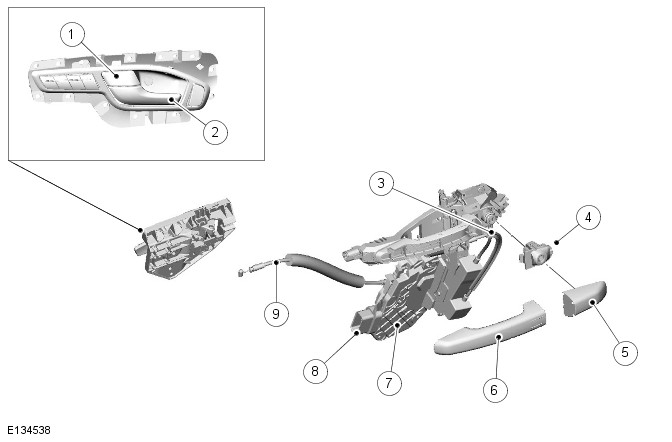
- Door interior lock/unlock button
- Door interior release handle
- Door lock exterior release cable
- Emergency mechanical door lock (front LH door only)
- Exterior door handle lock cover
- Exterior door handle
- Door latch
- Electrical connection to door control module
- Door lock interior release cable
The door latches are installed at the rear edge of each door and engage with corresponding strikers mounted to the 'B' and 'C' pillars. Each interior and exterior door handle is connected with a release cable to the corresponding door latch. In the front LH door a third release cable is connected between the door latch and the concealed emergency mechanical door lock.
Each door latch is a sealed unit that comprises the following:
- Lock motor
- Double lock motor (all except North American Specification (NAS), Japan and Gulf vehicles)
- Door ajar switch.
An electrical connector is incorporated in each door latch and provides the interface with the door control module and CJB.
The front door control modules are connected to the CJB on the medium speed CAN bus; the rear door control modules are connected via the LIN bus to the front door control modules.
The lock and double lock motors control the engagement of the door latches with the release cables to lock and unlock the vehicle. When the vehicle is locked, the lock motors disengage the door latches from the exterior release cables. When the vehicle is double locked, the double lock motors also disengage the door latches from the interior release cables. When the vehicle is subsequently unlocked, the interior and exterior release cables are re-engaged with the door latches.
All the door interior release handles incorporate a locking button. When a front door central locking button is pressed, all the vehicle doors will centrally lock/unlock. When a rear door locking button is pressed, the locking button will only lock/unlock the activated rear door.
When the door locking button is pressed, the interior release cable is pushed and causes the exterior release cable to be disengaged from the door latch. On the rear doors, pressing the locking button will also disengage the interior handle from the interior release cable.
When the door locking button is pulled away from the door, the door interior release handle is re-engaged with the interior release cable. As the interior release cable is re-engaged it is pulled, causing the door latch to re-engage with the exterior release cable.
Rear Door Child Locks
The rear door latches incorporate child locks that provide additional rear occupancy safety. The child locks are manually operated using the emergency key blade within the remote handset. Setting the child lock to the locked position will disengage the door latch interior release cable from the door latch, and prevent opening of the rear door using the interior release handle.
For further information on child locks, refer to the Owner's Handbook.
Door Ajar Switch
An ajar switch is installed in each door latch and is hardwired to the CJB. If the ignition is in power modes 4 (Accessory) or 6 (Ignition) and a door is opened or is not fully closed, the corresponding door ajar switch is opened to disconnect the ground from the CJB. A message is transmitted by the CJB via the medium speed CAN bus to the instrument cluster, to inform the driver that a door is ajar.
On vehicles with a low-line instrument cluster the door ajar symbol is illuminated.For additional information, refer to: (413-01 Instrument Cluster)
On vehicles with a high-line instrument cluster, the door ajar symbol is illuminated and a message is also displayed in the message center.For additional information, refer to: (413-08 Information and Message Center)
The door ajar switch is also integrated with the vehicle security system and is used as the detection device for unauthorized vehicle entry.For additional information, refer to: (419-01A Anti-Theft - Active)
HOOD LATCHES
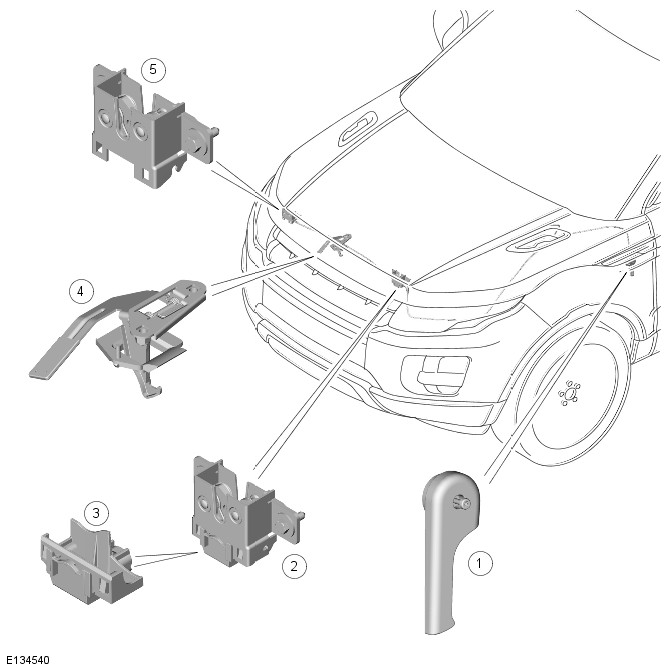
- Hood release handle
- LH hood latch
- Bonnet switch
- Hood safety hook
- RH hood latch
The hood is secured in the closed position by 2 latches located on each side of the hood latch panel. The hood release lever is located below the instrument panel on the LH 'A' pillar and is connected with a cable to the hood latches.
Operation of the hood release lever will open the 2 hood latches and release the hood.
A mechanically operated safety hook is installed at the front center of the hood. The safety hook prevents the hood from fully opening in the event that the hood latches are open, and the vehicle is in motion. The safety hook is spring operated to bias the hook to the latched position, and is formed with a lever plate. The lever must be pressed to release the safety hook from the mating latch plate when the hood is to be fully opened.
Hood Ajar Switch
The RH hood latch incorporates the hood ajar switch that is hardwired to the CJB. If the ignition is in power modes 4 (Accessory) or 6 (Ignition) and the hood is opened or is not fully closed, the hood ajar switch is opened to disconnect the ground from the CJB. A message is transmitted by the CJB via the medium speed CAN bus to the instrument cluster, to inform the driver that the hood is ajar.
On vehicles with a low-line instrument cluster the hood ajar symbol is illuminated.For additional information, refer to: (413-01 Instrument Cluster)
On vehicles with a high-line instrument cluster, the hood ajar symbol is illuminated and a message is also displayed in the message center.For additional information, refer to: (413-08 Information and Message Center)
The hood ajar switch is also integrated with the vehicle security system and is used as the detection device for unauthorized vehicle entry.For additional information, refer to: (419-01A Anti-Theft - Active)
TAILGATE LATCH
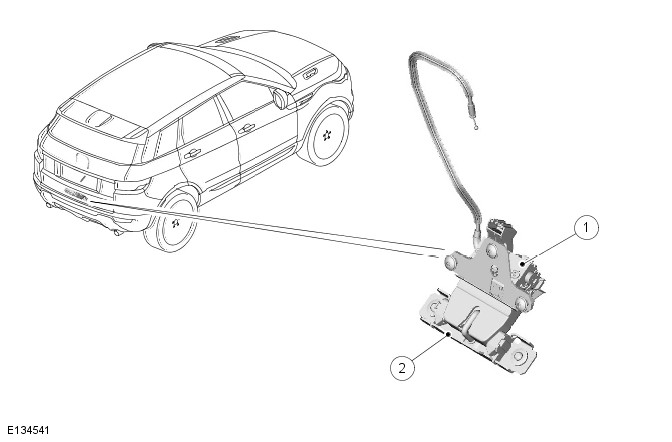
- Tailgate latch
- Tailgate striker
The tailgate latch is mounted at the bottom center of the tailgate interior body panel and is a fully electrically operated unit. The tailgate latch incorporates the tailgate lock motor, and receives a power supply via a hardwired connection from the CJB (The manual variant is not fully electrical and does not incorporate the tailgate lock motor). A release microswitch is housed within a touch-pad that is located on the underside of the tailgate exterior handle.
The tailgate latch is released by the CJB when the vehicle is stationary and either the remote handset button is pressed, or the exterior handle touch-pad is applied. It can also be released by the button in the cabin (with the handle which has the tailgate symbol on it).
Tailgate Ajar Switch
The tailgate latch also incorporates the tailgate ajar switch that is hardwired to the CJB. If the ignition is in power modes 4 (Accessory) or 6 (Ignition) and the tailgate is opened or is not fully closed, the tailgate ajar switch is opened to disconnect the ground from the CJB. A message is transmitted by the CJB via the medium speed CAN bus to the instrument cluster, to inform the driver that the tailgate is ajar.
On vehicles with a low-line instrument cluster the tailgate ajar symbol is illuminated. For additional information, refer to: (413-01 Instrument Cluster)
On vehicles with a high-line instrument cluster, the tailgate ajar symbol is illuminated and a message is also displayed in the message center.For additional information, refer to: (413-08 Information and Message Center)
The tailgate ajar switch is also integrated with the vehicle security system and is used as the detection device for unauthorized vehicle entry. For additional information, refer to: (419-01A Anti-Theft - Active)
FUEL FILLER DOOR ACTUATOR
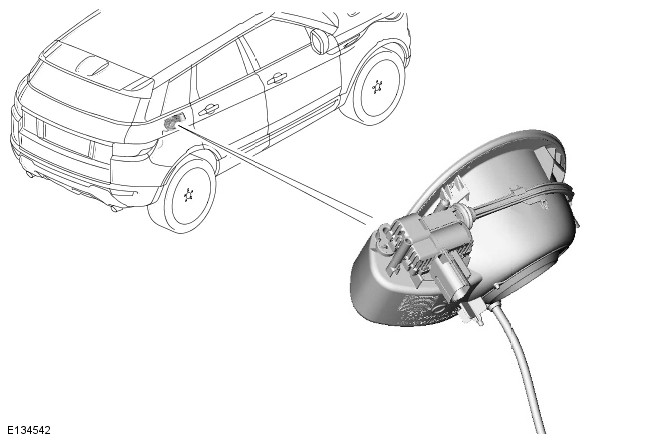
The fuel filler door is electrically locked and unlocked with an actuator and plastic pin. The actuator is located behind the fuel filler door housing, and operates the pin to engage or release a spigot on the door mounting hinge arm.
NOTE: Locking feature is not available on NAS spec cars.
The fuel filler door actuator is hardwired to the CJB and is operated by the vehicle central locking system. The CJB reverses the polarity of the actuator power and ground connections, allowing the pin to move in both directions for locking and unlocking. When unlocked, the fuel filler door is manually opened to gain access to the fuel tank filler cap.
CENTRAL LOCKING SYSTEM CONTROLS
The central locking system provides the driver with control over the locking and unlocking of the vehicle entry points, from inside or outside the vehicle. Manual operation of the central locking system is achieved using the following:
- Remote handset and RF receiver
- Front door central locking button
- Instrument panel central locking switches.
Remote Handset and Emergency Mechanical Door Lock
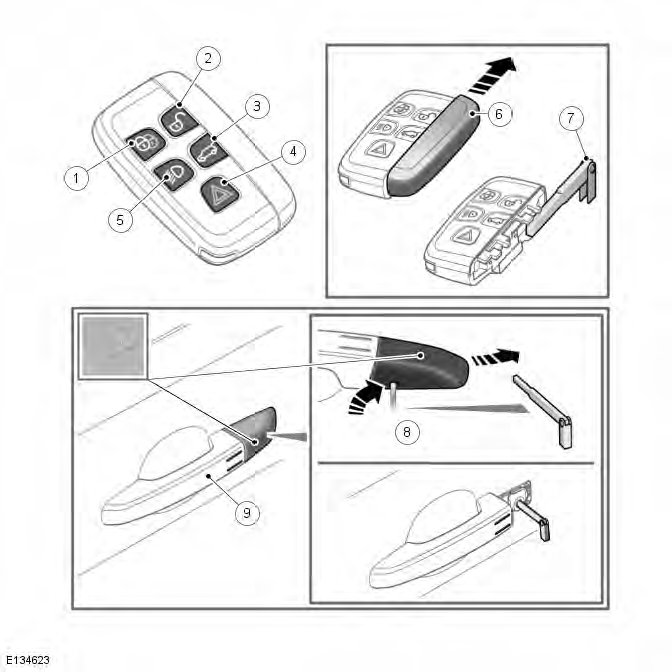
- Vehicle lock button
- Vehicle unlock button
- Tailgate unlock button
- Panic alarm button
- Headlamp delay function button
- Emergency key blade cover
- Emergency key blade
- Concealed mechanical lock
- LH front door handle
The remote handset contains an emergency key blade, concealed in the key fob. The front LH exterior door handle incorporates a mechanical operated door lock that is concealed behind a removable plastic cover. The door lock allows the front LH door to be mechanically unlocked and locked using the emergency key blade in the event that the remote central locking operation fails, or a vehicle power failure occurs.
When the mechanical door lock is used the central locking system will not operate, and if already armed the vehicle alarm will sound when the door is opened. The vehicle is not able to be double locked, or the alarm system armed using the emergency key blade.
The remote handset contains a Printed Circuit Board (PCB), transponder and a battery.
The remote handset contains an emergency key blade, concealed in the key fob. The emergency key blade is used to access the vehicle through the LH front door if the central locking system fails. The emergency key blade is also used to enable or disable the rear door child locks, and to disable the passenger airbag.
Refer to: Air Bag Supplemental Restraint System (SRS) (501-20B Supplemental Restraint System, Description and Operation).
The remote handset is identical for all vehicle specifications, but differs in the preset frequency and power that the remote handset operates. The remote handset for each vehicle specification is identified by a suffix change to the base part number as follows:

Each remote handset features a unique identification code that is programmed within the integral transponder. The RF signal produced by the remote handset contains the unique identification code and also a rolling code. During vehicle production, the unique identification codes of the valid remote handsets are programmed into the RFA, and the rolling codes are also synchronized with the RFA.
When the remote handset is operated, the RFA checks the unique identification and rolling code. The RFA will only respond if the RF signal produced is from a valid remote handset for the vehicle. For additional information, refer to: (419-01A Anti-Theft - Active)
A total of 8 'slots' are available in the RFA software to allow for replacement and the addition of remote handsets. In service, the Land Rover approved diagnostic system may be used to communicate with the RFA for the following:
- Identification of remote handset allocation within the RFA.
- Enabling of new remote handsets.
- Disabling of existing remote handsets.
If the remote handset rolling code loses synchronization with the RFA, the remote handset functions will not operate.
Synchronization between the remote handset and RFA is restored automatically when buttons are pressed.
Additional buttons are located on the remote handset to provide convenience operation of the tailgate release, headlamp delay and panic alarm functions.
RF Receiver
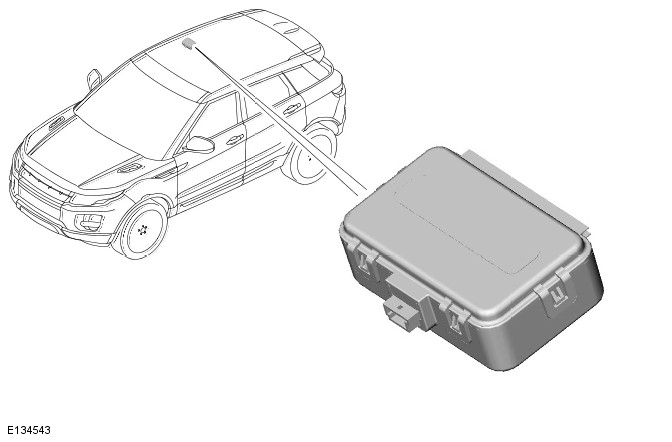
The RF receiver is installed on the headlining on RH side at pillar 'B'. The receiver provides functionality for the remote central locking system.
NOTE: TPMS (tire pressure monitoring system) is provided by a separate receiver.
The RF receiver is identical for all vehicle specifications, but differs in the preset frequency that the receiver operates. The RF receiver for each vehicle specification is identified by a suffix change to the base part number as follows:

The RF receiver converts the signals transmitted by the remote handset into digital messages, and then transmits the message via the ISO9141 bus to the RFA.
A permanent power feed is supplied to the RF receiver by the CJB.
Front Door Central Locking Button
Both the front door interior locking buttons will activate the central locking function. When a front door central locking button is pressed, all the vehicle doors will centrally lock/unlock.
When a front door central locking button is pressed, the door control module on the activated door transmits the central lock/unlock request to the CJB. The CJB then transmits the central lock/unlock command to all the vehicle door control modules to lock/unlock all the vehicle doors.
The central locking feature using the front door central locking button is inhibited if either of the front doors is ajar. If a front door is ajar when a front door central locking button is pressed to lock the doors, the doors will lock and then instantly unlock.
Torque Specifications


